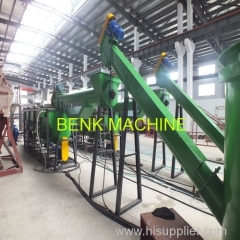

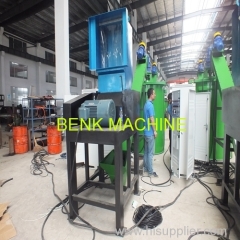


PE film washing line
| Min. Order: | 1 Set/Sets |
|---|---|
| Trade Term: | FOB,CFR,CIF,DAT,DAP,CIP,CPT,EXW |
| Payment Terms: | Paypal, L/C, D/P, D/A, T/T, WU, Money Gram |
| Place of Origin: | Jiangsu |
Company Profile
| Location: | Suzhou, Jiangsu, China (Mainland) |
|---|---|
| Business Type: | Manufacturer, Trading Company |
Product Detail
| Means of Transport: | Ocean, Air, Land |
|---|---|
| Use: | Bottle Crusher |
| Plastic Type: | PP/PE |
| Shaft Design: | Single |
Product Description
Plastic Film Washing Line
Plastic film washing lines are an integral part of the plastic film recycling process. A plastic film washing line consists of a set of washing equipment that uses friction and high speeds to throughly wash dirty or soiled plastic films, such as LDPE film, into clean films suitable for pelletizing, the process of melting plastic into plastic granules, or reprocessed plastic pellets. These plastic pellets can then be used as raw materials for manufacturing new products.
Generally speaking, a plastic film washing line is composed of several pieces of core equipment that include a shredder or granulator, high-speed friction washer, a gravity "sink/float" separation tank, and a dewatering / drying system. The material moves from one machine to another using belt/screw conveyors and or vacuum hosing. Although washing equipment comes in various models, some with innovative designs and technology, the general concept of each equipment remains the same. Additional machinery such as rotating trommels, air classifiers, or bouncing conveyors/tables can be added to remove specific contaminants and improving the overall quality/cleanliness of the washed films.
Shredders & Granulators
The first process in any plastic film washing line is size reduction. Using a shredder or granulator, whole plastic bags, long strips of plastic films, and films that are clumped together are turned into small, free-flowing pieces around the size of your hands (or smaller). Size reduction solves various issues with recycling plastic film:
1 Whole plastic bags and large strips of plastic films can easily tangle conveyors and rotary based washing equipment slowing production rate and increasing the potential of damaging the expensive machinery. /li>
2 Plastic film such as saran wrap and LLDPE film have the natural tendency of clumping or sticking together. Plastic films are also frequently packaged in tight bales, compacted bundles of film, which presses the films together making washing nearly impossible. During the size reduction process, spinning blades mechanically break the clumps apart and unwrap stuck together films.
3 Free-flow is a requirement for the film to move from one washing equipment to another.
To achieve size reduction, the machine of choice is usually a wet granulator or industrial shredder. Both machines accomplish the goal of reducing the plastic film into smaller pieces, however, in two different manners.
Shredders
Industrial shredders are heavy-duty, low-speed, high-torque machines. Shear blades in various shapes and sizes are mounted on a solid rotor or shaft, or multiple hexagonal shafts, and rotated to produce a cutting / shredding motion. With robust, hooked styled shear blades rotating at relatively slow speeds, shredders have the unique ability to quietly shred large pieces and high volumes of feed stock into random, smaller pieces between 1-5 inches. The low speed of the rotors also ensures that little or not dust is generated.
Shredders come in a variety of models and are classified using the number of shafts; that is, there are single-shaft, dual-shaft, and quad-shaft shredders available depending on your application. Common uses of shredders in recycling besides plastics include:
4 Rubber or tire recycling.
5 Metal recycling
6 E-waste or WEEE recycling
7 Destruction of products for liability issues including sensitive documents, computer storage media such as harddisks, x-rays, expired goods, outdated stock, pharmaceuticals, and more.
8 Wood recycling – scrap wood can be shredded to produce particle wood or boards.
9 Size reduction in wastewater treatment plants and other municipal applications.
10 Other solids – destruction of foods, pallets, steel and plastic drums, furniture, construction debris, containers, corrugated boxes, packaging, labels, and other bulky materials.
For plastic film recycling, specifically in an automated washing line, shredders are extremely useful as films can be batch fed; That is, large bales of film can be feed into the shredder. The baling of plastic film into large, compact bundles is standard practice for most recycling centers where films are consolidated and trucked or shipped abroad to processing facilities. By baling the loose films, recycling centers can save on inventory space and lower logistic costs. Plastic film bales vary in size depending on the type of baling equipment used and the experience of the operator, however, most will be around 3 – 5 feet in length, width, and height with each bale weighing between 500 – 1,500 pounds.
Granulators
Plastic granulators, unlike shredders, operate at much higher speeds, around 200-800 rpms. Heavy-duty knives are mounted at an angle (often times adjustable) on an open, hollow rotor in various arrays. When the blades on the fast spinning rotor makes contact with the stationary blades on the granulator housing, the feed stock is cut into relatively fine flakes or regrinds. At the bottom, or surrounding the spinning rotor is a sizing screen, a metal screen with holes the size of your desired output. The plastic film remains in the cutting chamber until it reaches the desired size, usually between several inches down to 1/8 of an inch, and falls through.
Although plastic granulators offer the unique ability to produce smaller sized outputs, the fast moving parts make granulators very noisy to work with and produces high amounts of dust or fines. Manufacturers of higher quality granulators often offer the option of a soundproofing outer case and methods for dust/fines reduction through the use of added screens, reduced speeds, vacuums, and wet granulation.
For the purpose of washing plastic film, most will suggest the use of a wet granulator. Wet granulators work in the same fashion except with a constant stream of water being sprayed into the cutting chamber. This setup is ideal in most plastic film washing lines because it not only accomplishes size reduction, the added water helps to initially clean or "pre-treat" dirty films before it reaches another set of washing equipment. The added water also acts as a lubricant for the rotating blades to reduce heat and friction, allowing the blades to last much longer before sharpening.
Shredder vs. Granulator
The question of which size reduction equipment to use in a plastic film washing line remains unanswered as each type of machine has its own advantages and disadvantages. In fact, there are washing plants that use both pieces of equipment. A shredder is initially used to break large bales of plastic film into hand sized pieces. These hand-sized pieces are then feed into a wet granulator where it is "pre-cleaned" and further reduced in size. Now that you have a better understanding of what a shredder and granulator is, let's look into the pros and cons of each type of machinery:
Shredder Pros & Cons:
§ Shredders can cut through entire bales of plastic film reducing the amount of manual labor required. That is, large bales of plastic film can be fork-lifted into the large-mouthed feeder; Some film recycling plants use a mini-crane system.
§ Shredders, operating at low speeds, are must quieter and produces less dust and fines.
§ The size and shape of plastic film cut with a shredder is not ideal; the cut pieces are not uniform, and relatively large.
§ Shredders are more difficult to maintain where sharpening and interchanging blades can be difficult and time consuming.
§ Another benefit of its lower speed operation is low rate of wear & tear. While this is not true for single-shaft shredders, dual-shaft & quad-shaft shredders are usually equipped with "overload protection"; That is, if the plastic film becomes stuck or tangled in the machine, the rotors will automatically stop and go in reverse.
Hence, if you're dealing with lower quality plastic films that have more contaminants (dirt, rocks, metals, glass, etc…), a shredder is recommend since it can tolerate higher levels of contamination.
§ Some manufacturers offer shredders capable of wet processing.
Plastic Granulator Pros & Cons:
§ Plastic granulators cannot take in entire film bales, instead, baled films must first be manually loosened and feed into the machine piece by piece. A "bale opener" or "debaler" machine can be added to washing lines to automate this process.
§ Granulators, operating at high speeds, are very noisy and produces large amounts of dust and fines in the air. Oftentimes, an soundproofing case surrounds the granulator to reduce noise.
§ Plastic film cut using a granulator is ideal; the cut pieces are relatively uniform and small.
§ Granulators are easy to maintain where blades can be easily mounted and taken out for sharpening.
§ Granulators have much higher wear & tear as it operates in high speeds. Operators must be careful about accidentally putting hard objects such as metals (nuts & bolts) and rocks into the cutting chamber as this will easily damage the machine & blades. The fast spinning blades may also propel these hard objects causing potential hazards in the work environment.
If you plan on washing plastic film that has high levels of contamination, a shredder is recommended over a granulator.
§ A wet granulator partially cleans and "pre-treats" the plastic film.
High-Speed Friction Washer
The high speed friction washer is a recommended but not required piece of equipment in a plastic film washing line. At the core of a friction washer is a long, fast-rotating shaft mounted with many tilted panels or paddles. Surrounding this rotating shaft is a mesh screen tunnel used for dewatering. These are then encased within a retangular box where water jets and nozzles are mounted and directed at the mesh screen. The entire machine is set at an incline with plastic films being feed into a vertical feeder located on the lower end and cleaned plastic films exiting at the top.
Generally speaking, friction washers are placed after a wet granulator. The slurry mix of dirt, water, and size reduced plastic films enter the friction washer at a constant rate where the rotating shaft is already spinning at speeds upwards of 1,000 rotations per minute. As in its name, the spinning panels constantly hit the film pieces at high speeds causing friction to occur. As the film pieces are rubbing against each other, debris is scrubbed off and thrown at the mesh screen via centrifugal force. Finer particles of dust, dirt and water exit the chamber at this time. The water jets continuously spray water at the mesh screen reducing clogging and adding water into the friction chamber.
While friction washers are not required, it's highly recommended for films that have slight paper or cardboard contamination. This is because the friction generated within this equipment is enough to break apart paper and cardboard into tiny fibers that exit through the mesh screen.
As the panels are angled upwards, the flow of plastic films move upwards and exit the friction washer at the top where it'll usually enter a gravity separation tank or more advance hydrocyclone equipment. For most plastic film recycling plants, friction washers are a great addition to the washing line. However, some processors may choose to not use friction wasters, instead, use long rows of water troughs or separation tanks. In this scenario, plastic film is allowed to soak for longer periods of time helping loosen the debris.
Gravity Separation Tank
The gravity separation tank serves two purposes:
11 Cleans: The plastic film is allowed to soak in a large tank of water loosening debris.
12 Separation: The loosened debris and heavier contaminants will sink while the plastic films float. The top layer continues to the next step in the washing line while the sunk particles are removed.
A gravity separation tank, sometimes referred to as float/sink tank, is a large, rectangular tank of water usually 2-3 meters wide, 4-6 meters long, and 2-3 meters high. Water is filled to the top and requires constant replacement due to water loss and evaporation. Plastic films enters the separation tank and is propelled forward lengthwise via slow rotating paddle drums and sometimes through the use water jets.
As the plastic film soaks and bathes within this large tank of water, debris and other contaminants sink to the bottom while the plastic films float and is propelled forward. This piece of equipment uses a basic property of water, its density, to aid in separation; The density of water is 1 g/cm3, anything entering with density lower than 1 g/cm3 will float, whereas, anything with density higher than 1 g/cm3 will sink. In the case of plastic LDPE film, it's density is between .91-.94 g/cm3, hence it will float. Rocks, sand, and gravel that pass through the granulators and friction washers will now be removed as it has the approximate density of 2-3 g/cm3.
This makes gravity separation an essential part of any plastic film washing line. In fact, for most common plastics, only polyethylene (what ldpe film or low-density polyethylene is made out of) and polypropylene have densities less than 1 g/cm3. Hence, a small portion of other films not made from polyethylene and polypropylene will also be removed at this time, which is ideal.
The bottom of a separation sank is tapered where all the sunk waste is collected and removed using either a screw/belt conveyor or redler mounted at an incline or pneumatic valves. This collected waste, composed mostly of water and dirt is either buried or professionally landfilled.
Hydrocyclones
Hydrocyclones, used more for PET bottle recycling, can also be used for plastic film washing. It serves the same purpose as separation tanks where plastic films are separated from heavier contaminants, however, in a more efficient manner with much higher separation effect, approximately 20 times earth's gravity. In hydrocyclones, pressure jets excel the water mixture of films and contaminants within a cylindrical apparatus. The cyclone generated pushes the lighter plastic films outwards and upwards while heavier contaminants move inwards and downwards. The cyclone's sensitivity and selectivity can be adjusted by choosing the nozzle sizes of the exiting outlets at both the top and the bottom.
Wether a separation tank or hydrocyclone is used, the plastic film at this time should be very clean, contamination free, and ready for dewatering and drying.
Drying Systems
The last step of a plastic film washing line is the drying process. The wet plastic films need to be dried before it becomes extruded into plastic granules, the final step of the plastic film recycling process. In the extrusion process, plastic films are melted into a continuous flow of molten polyethylene plastic and squeezed through a die (similar to how spaghetti is made) and then cut into pellets or granules. If the plastic films are not dried properly before being extruded, the moisture become trapped within the molten plastic creating air bubbles in the final granules. To ensure this does not occur, moisture content must be controlled below 15%.
There are two generally accepted methods of drying plastic films in a washing line. The first and more common method is via a dewatering machine or horizontal centrifuge accompanied with thermal heaters. The dewater machine removes excess water via centrifugal force. Effective to a degree, dewatering will bring moisture levels of wet plastic films to around 20-30%. The rest of the moisture is removed via a thermal dryer, much like a hair dryer.
The second method, more economical, uses a screw press to mechanically squeeze and twist the plastic film. The resulting film is typically dry enough for extrusion, approximately 15%.
Dewatering / Thermal Heater
The dewatering machine or horizontal centrifuge is built very similar to a high speed friction washer. At the center of a dewatering machine are many panels or paddles mounted on a shaft that spins at high speeds of around 1,000 rotations per minute. Surrounding this fast spinning shaft is a mesh screen tunnel. The entire apparatus is encased in a metal container where the electric motor is externally mounted.
As the wet plastic film enter the dewatering machine, the spinning panels throw the plastic films around and against the mesh screen via centrifugal force. At this time, excess water exits through the mesh screen while the plastic films are contained within.
Thermal heaters use hot air to dry the plastic films. After dewatering, the plastic films are vacuumed out by a transport blower and mixed with hot air traveling through a long transport tubing that winds back and forth. The plastic films mix and spin around within the lengthy transport tunnel until entering a cyclone separator where the residual moisture is further reduced. While 1 set of thermal heater is usually enough, some washing plants may opt for 2 or 3 thermal heaters positioned in a row to ensure the lowest possible moisture levels.
Dewatering Screw Press
Dewatering screw presses are commonly used in food processing, paper & pulp industries, sewage disposal, and much more. This robust piece of machinery offers excellent moisture reduction capabilities without the high cost (electricity cost) of operating thermal heaters.
At the core of a dewatering screw press is a screw shaft of increasing diameter. The screw shaft is most narrow at the opening where the plastic film first enters via a vertical feeder. Surrounding the screw shaft is a thick-walled, constant diameter outer tube lined with tiny holes for water outlet. The common dewatering screw press for plastic film washing lines is 4-6 meters long, but can be increased or decreased based on application. As the wet plastic film is feed into the feeder, the screw shaft slowly rotates moving the plastic film forward. As the screw shaft becomes thicker in diameter, the plastic film becomes more and more compacted against the outer casing wall. The moisture from the plastic film is squeezed out and exits the tiny holes.
At the end of the horizontal screw press, the diameter of the screw shaft is only slightly smaller than the inside diameter of the outer casing. It's through this narrow gap that the dried plastic film exits the screw press. A well manufactured screw press will bring moisture content to acceptable levels of below 15%.
Customizing A Plastic Film Washing Line
This article covers the basic washing equipment used in a standard plastic film washing line. The arrangement of machines, the number of machines to use, as well as if other more advance equipment is required will depend on the actual type of plastic film being recycled and the level of contamination. For instance, in our discussion of a granulator versus a shredder above, a granulator should not be batch fed and is more limited on the level of contamination. Whereas a shredder can better handle higher volumes with more contamination.
A typical LDPE film washing line recycling clean, so-called "98/2 films", or "A Grade Film" will be composed of a wet granulator, then friction washer, then separation tank, then drying using a horizontal centrifuge and thermal heaters. Variations of this setup can also be very effective such as the removal of the friction washers and adding longer rows of separation tanks. Some plastic washing plants use two friction washers, one before and one after the separation tank. To lower the wear and tear of the granulator, a shredder can be placed into the washing line before the wet granulator which initially reduces the plastic films to small pieces before being further granulated.
Of course, the more pieces of machinery used, the cleaner the outcome of plastic films will be. While this is so, recycling plant owners must consider initial investments and operations cost when deciding the amount of washing machines to use. The more equipment used, the higher the initial investment. The more pieces of equipment used, the higher the electric and water consumption which dramatically increase operation costs. In countries where manual labor is low, some equipment can be replaced by manual labor. Or, instead of using conveyors to move the plastic film from one machine to another, manual movement can be considered.
In conclusion, this article is written so you can get a better understanding of typical machinery used in a standard plastic film washing line. There is no proper way of setting up a film washing plant, however, careful consideration should be made based on the type of plastic film being recycled as well as the type and amount of contamination within. Lastly, not all washing equipment is equal and visits to manufacturers of washing equipment is suggested especially those made in China. How to choose high quality equipment will be discussed in another article.
Plastic Granulator
A plastic granulator is a machine used for size reduction, an essential step in plastic recycling. Plastic granulators have the ability to quickly break down plastic products such as plastic bottles, crates, drums, and films into small, uniform pieces called "regrinds" or "flakes". In some cases, this maybe the only step required before it can be reused in manufacturing new plastic products. For the most part, however, recycling of plastic scrap requires much more resources in sorting and separation, size reduction, washing, and pelletizing.
In a plastic granulator, cutting knives are mounted on an open rotor spun to high speeds by an electric motor. This rotor is encased in a cutting chamber where stationary knives are mounted. As the plastic scrap enters this cutting chamber, the rotating knives come into contact with the stationary knives cutting the plastic into little pieces. A large screen with many holes is placed at the bottom. The plastic will continue to mix and be cut by the knives until it is small enough to fall through this screen. Hence, by adjusting the size of the holes, one can control the size of the cut shreds.
Types of Plastic Granulators
Although the basic concept of how granulators work is the same, you'll find manufacturers offering granulators with various cutting chamber designs and knife arrangements. Generally speaking, there are three mainstream types including:
1 Double Scissor Cut or Double Angle Cut – In a double scissor cut granulator, straight rotor knives are aligned in parallel at a slight angle; Slanted just several degrees from being completely horizontal. The stationary knives are also aligned in parallel at the same angle, however, in the opposite direction of the rotor blades. This ensures a constant cutting gap along the full length of the knives which results in low temperature increases during granulation and minimal power consumption. Most manufacturers recommend the double scissor cut as this blade geometry in combination with an open rotor design provides cleaner "true scissor" cuts with fewer fines, less noise, and higher capacities.
2 Chevron or V-type Rotor – As in its name, Chevron style rotors have granulator knives arranged in a V shape (similar to the Chevron logo) that are mounted in parallel. The cutting edge is on the inside of the V with stationary knives that are either straight or also in the V design. As the rotor knives spin past the stationary knives, the plastic feed stock is cut along the two cutting edges that start initially on the outside edges and coming together into a single point. While most manufacturers recommend the double scissor cut, the V-shape rotor designs also have a large fan base. Double scissor cutting is indeed ideal when the blades are sharp, however, as the blades dull, much of the plastic is pushed to one side of the granulator's cutting chamber. As the granulator continues to operate, one side of the knives will become more dull causing uneven wear, friction, increased electric consumption, and more fines. A V-shape granulator, on the other hand, continues to push plastic scrap inside the cutting chamber toward the center even as the blades dull. As the V-shape rotor knives pass the stationary knives, larger plastic pieces are clamped within the diminishing cutting area which solves another issue of double scissor cutting machines; plastic pieces often squirm or move about before they are cut.
3 Helical Rotor – In a helical rotor granulator, knives are arranged in a helix or spiral design in a closed rotor. Unlike open rotors of the previously discussed granulator types which are well suited for injection or extrusion plastic scrap, a closed-rotor design is robust, durable, and can withstand greater impact load, perfect for granulating thick cross-components.
Granulator Speed & Granulation Rates
The speed or capacity of a granulator depends on several factors including the type of material, size of the cutting chamber and knives, the quality of knives used, the quantity of knives, the speed of the electric motor, and the size of the screen. A combination of these factors will determine how quickly the granulator can produce regrinds of plastic scrap. Let's take a closer look at each of these factors:
Type of Material – The most common consumer plastics, polyethylene (PE) and polypropylene (PP), are soft plastics with high impact strength that can easily be cut. These are much faster to granulate compared to engineering plastics such as ABS, Nylon, and PC that are much tougher to fracture and will shatter when exposed to high force.
Size of Cutting Chamber & Knives – A large cutting chamber combined with longer rotor and stationary knives results in higher volumes of plastic scrap the granulator can process at one time.
Quality of Knives – While the design of the rotor and the arrangement of knives play an important role in cutting, all is loss if low quality knives are used. Low quality knives highly affect production as they require constant sharpening and dull easily which lowers granulation rates. In general, high quality knives are made from high-carbon, high-chromium D2 / SKD 11 steel.
Quantity of Knives – The number of rotor and stationary knives depend on how the granulator is designed. On the most part, granulators have 3-6 rotor knives with 2-3 stationary or fixed knives. While this is so, some models of granulators may have more than 30 rotor knives. A combination of the size of cutting chamber, the type of granulator, and the number of knives, and speed of motor will affect the speed of a granulator.
Electric Motor – Granulators work by a spinning rotor, the faster it spins to a certain degree, the higher the cutting action within the cutting chamber. Rotors within a granulator usually spin between 200-800 rotations per minute depending on the power of the electric motor which can range from less than 1 kw/h to something monstrous like 800 kw/h.
Screen Size – At the bottom of a granulator's cutting chamber is a metal screen with circular holes. The regrinds remain in the cutting chamber until they are small enough to fall through. Hence, if you require the regrinds to be very fine, you'll use a screen with very small holes. The granulation time will also increase as the plastic feed stock must stay in the cutting chamber for longer periods of time. In general, screen hole sizes range from 1 inch to 1/8 inch, or 25mm to 3mm in diameter.
Wet Granulator
A wet granulator is a granulator with added water jets or hoses aimed inside the cutting chamber. The water is contained within the cutting chamber via the addition of extra seals. To prevent rust, the rotor and granulator housing are plated with chrome nickel alloy or are galvanized.
A wet granulator has many benefits over drying processing primarily as it partially cleans the plastic during size reduction. The water also acts as a lubricant between the rotor and stationary knives. In the dry granulation process, the knives usually become hot enough to melt the plastic within the cutting chamber. This makes cleaning the granulator slightly difficult as melted plastic must be scraped off. With wet granulators, the added water significantly lowers friction between the knives lowering the temperature way below plastic's melting point. It's been proven to also reduce the dulling of the knives reducing up the three times the need for sharpening.
A wet granulator is commonly used in plastic film washing lines.
Proper Granulator Usage
A couple operating tips for properly operating a granulator:
4 Never start the granulator with material still inside the cutting chamber.
5 Keep foreign objects on or around the granulator away during operation.
6 Granulators were not meant for large lumps or purgings.
7 Always empty the collection bin on-time, do not let the collection bin overload into the cutting chamber.
8 Do not batch feed a granulator. Shredders are much more adapt to batch feeding.
9 Turn the granulator on before feeding the plastic into the machine.
10 Do not overload the granulator by over feeding.
11 Inspect knives for wear and clearance. Adjust, sharpen, and replace as necessary.
12 Rotate the granulator screen routinely to extend screen life.
13 Allow the granulator to purge before turning it off.
14 If a blower is being used to evacuate the cut regrinds, make sure to stop the granulator before stoping the blower 30 seconds later.
Maintenance
Plastic granulators are designed to be robust and long lasting. However, it's very important to keep a granulator properly maintained which will prevent costly repairs or parts exchanges in the future. First and foremost, it is essential to routinely sharpen and rotate both the rotor and stationary knives. This will ensure maximum granulation efficiency as well as putting less stress on the wear and tear of the machine. During operation, make sure the keep foreign, stiff objects such as metals away. Commonly overlooked items such as nuts and bolts have the potential to severely damage a granulator by chipping knives, damaging the rotor, and even breaking through a granulator's casing. Always keep an eye on the granulator screen making sure it is not clogged during operation. A clogged granulator screen blocks cut pieces of plastic from exiting the granulation causing a buildup of material inside the cutting chamber which jams the rotor. A jammed rotor can lead to the premature wear of the drive belts, and in more serious cases, a burned out electric motor. Lastly, always keep the motor and bearings well oiled.
RELATED MACHINERY
WELCOME TO PE FILM WASHING LINE!


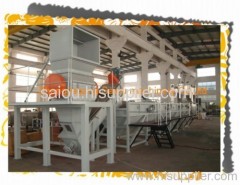
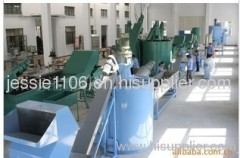
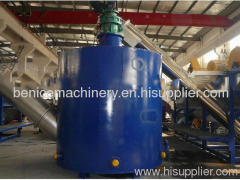

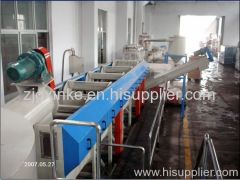
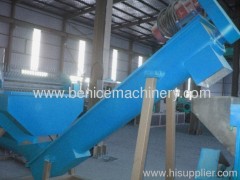
.jpg)